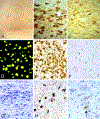Basal forebrain cholinergic system in the dementias: Vulnerability, resilience, and resistance
- PMID: 34272732
- PMCID: PMC8458251
- DOI: 10.1111/jnc.15471
Basal forebrain cholinergic system in the dementias: Vulnerability, resilience, and resistance
Abstract
The basal forebrain cholinergic neurons (BFCN) provide the primary source of cholinergic innervation of the human cerebral cortex. They are involved in the cognitive processes of learning, memory, and attention. These neurons are differentially vulnerable in various neuropathologic entities that cause dementia. This review summarizes the relevance to BFCN of neuropathologic markers associated with dementias, including the plaques and tangles of Alzheimer's disease (AD), the Lewy bodies of diffuse Lewy body disease, the tauopathy of frontotemporal lobar degeneration (FTLD-TAU) and the TDP-43 proteinopathy of FTLD-TDP. Each of these proteinopathies has a different relationship to BFCN and their corticofugal axons. Available evidence points to early and substantial degeneration of the BFCN in AD and diffuse Lewy body disease. In AD, the major neurodegenerative correlate is accumulation of phosphotau in neurofibrillary tangles. However, these neurons are less vulnerable to the tauopathy of FTLD. An intriguing finding is that the intracellular tau of AD causes destruction of the BFCN, whereas that of FTLD does not. This observation has profound implications for exploring the impact of different species of tauopathy on neuronal survival. The proteinopathy of FTLD-TDP shows virtually no abnormal inclusions within the BFCN. Thus, the BFCN are highly vulnerable to the neurodegenerative effects of tauopathy in AD, resilient to the neurodegenerative effect of tauopathy in FTLD and apparently resistant to the emergence of proteinopathy in FTLD-TDP and perhaps also in Pick's disease. Investigations are beginning to shed light on the potential mechanisms of this differential vulnerability and their implications for therapeutic intervention.
Keywords: Alzheimer's disease; TDP-43 proteinopathy; basal forebrain cholinergic neurons; diffuse lewy body disease; frontotemporal lobar degeneration; tauopathy.
© 2021 International Society for Neurochemistry.
Conflict of interest statement
Disclosure Statement
The authors have no conflicts of interest to declare.
Figures



References
-
- Aigner TG, Mitchell SJ, Aggleton JP, Delong MR, Struble RG, Price DL, Wenk GL and Mishkin M (1987) Effects of scopolamine and physostigmine on recognition memory in monkeys with ibotenic-acid lesions of the nucleus basalis of Meynert. Psychopharmacol. 92, 292–300. - PubMed
-
- Allen SJ, MacGowan SH, Treanor JJ, Feeney R, Wilcock GK and Dawbarn D (1991) Normal beta-NGF content in Alzheimer’s disease cerebral cortex and hippocampus. Neurosci.Lett 131, 135–139. - PubMed
-
- Alzheimer A (1977) A unique illness involving the cerebral cortex. In: Neurological Classics in Modern Translation, (Rothenberg DA and Hochberg FH eds.), pp. 41–43. Hafner Press, London.
-
- Araujo DM, Lapchak PA, Robitaille Y, Gauthier S and Quirion R (1988) Differential alteration of various cholinergic markers in cortical and subcortical regions of human brain in Alzheimer’s disease. J.Neurochem 50, 1914–1923. - PubMed
Publication types
MeSH terms
Substances
Grants and funding
LinkOut - more resources
Full Text Sources
Medical

